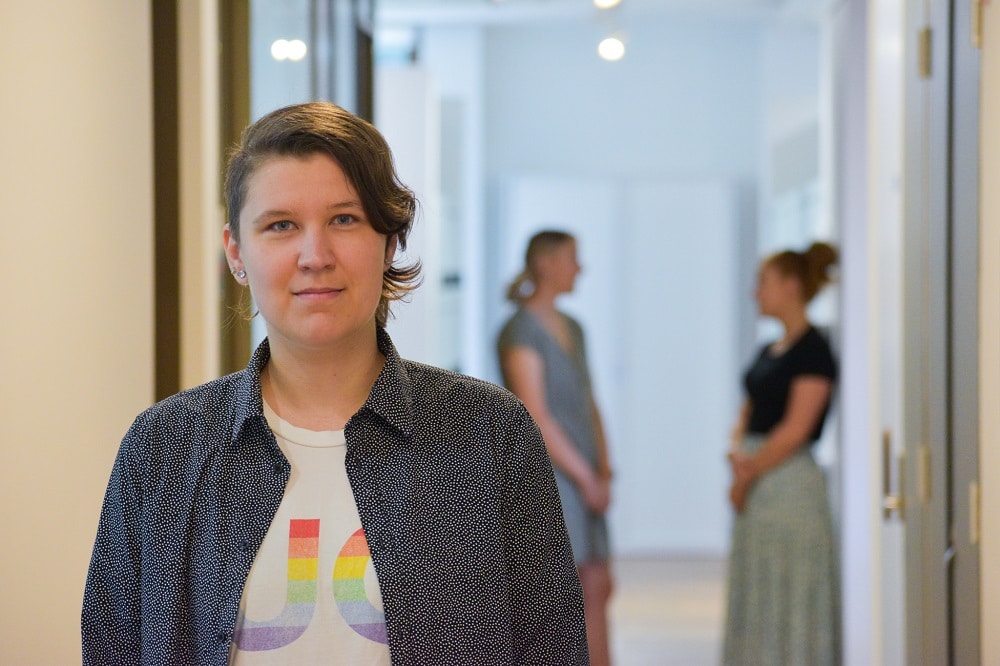Trans and gender diverse people face higher unemployment than the average population of Australia – but a gender diverse workplace benefits productivity, creativity and innovation, a University of Canberra researcher believes.
Robin Ladwig, a PhD candidate in business management at UC, has developed an application that could help workplaces and organisations to be more inclusive. (Mx Ladwig identifies as genderqueer, and uses the pronouns “they” / “them”.)
Mx Ladwig has launched an online questionnaire for people in human resources, career development, diversity and talent management, and leaders and managers to evaluate how trans and gender diverse people’s work experience and career development relate to organisational structures and policies. Earlier this year, they interviewed 20 gender diverse people across Australia about their workforce participation, satisfaction and career development.
“This survey will be a first step towards uncovering and understanding how gender diversity works within each organisation – how it is supported and understood,” Mx Ladwig said.
Gender diversity, they explained, means a fair and equitable representation of people – not just the binary of men and women, but other gender identities as well – a plurality.
“It’s not aimed at eradicating or excluding or rejecting female and male gender identity,” Mx Ladwig explained. “It’s about adding onto that, and accepting a few different gender identities.”
Encouraging gender diversity in the workplace, Mx Ladwig believes, focuses on the skills and interests of the person, rather than assigning skills and representation to gender, and letting stereotypes and stigma rule judgement.
“Gender diversity creates a much more positive, inclusive, and constructive work environment where everyone can feel or develop a feeling of belongingness, independent of their individual expression and identity,” Mx Ladwig said. “They can just be themselves and can concentrate on their work.”
But gender diverse people can struggle to find work, let alone thrive in it. Their unemployment rate is higher than the average population of Australia, too; a recent study by Equality Australia showed that trans and gender diverse unemployment rose from 15.2% pre-COVID to 20% in April, compared to 6.2% of the overall population. According to another study this year, 55% of young non-binary people reported discrimination and harassment, compared to 20.6% of other young people.
In 2013, the First Australian National Trans Mental Health Study (2013) declared that “the health of trans people in Australia [was] in a state of crisis … An alarmingly large number of trans people experience[d] high levels of mental distress (particularly depression and anxiety syndromes) and poor quality of life.” Nearly two-thirds of participants (64.8%) reported experiencing discrimination and harassment – ranging from social exclusion to violence and assault – while more than three-quarters of these (76.3%) changed their behaviour to avoid further harassment.
“This has implications for the workplace, as they’re not bringing their authentic selves to work,” Mx Ladwig said. “They’re changing their behaviour, demeanour or physical expression to hopefully fit into the organisation, and not experience discrimination or exclusion.”
Mx Ladwig said their research has already revealed enablers to gender diverse employment. Most important are a committed organisation where diversity is deeply included in the value system; strong leadership that is open, listens to employees, backs them up, and represents the values of the whole organisation; and a flexible organisation that focuses on the outcome rather than the structure.
“Here in Canberra, we’re pretty privileged,” Mx Ladwig said. “Canberra tries to – and I think it could be – the queerest city of Australia. There’s a lot of movement here in the ACT for gender diversity, for acceptance and inclusion, and respect – which again makes us pretty privileged.”
Some organisations – including the Australian Public Service – have policies to be more inclusive and acknowledge diversity in the workforce, Mx Ladwig pointed out. But they believe that may also be where difficulties lie.
“A lot of policy has been developed which is quite gender diverse and inclusive, but translating it into practice can be quite difficult,” Mx Ladwig said. “Policy is not always practised, so even if an organisation has a policy about gender diversity, does not mean their culture and daily work are actually influenced by that. There might not be any programs or structures that support the aim of the policy.”
The biggest barrier to gender diverse employment is a lack of knowledge, Mx Ladwig believes. Some employees may be afraid of hiring trans or gender diverse people, partially because they worry they will lose a certain customer base. Bureaucracy, too, can sometimes be quite binary, and not flexible in understanding what different employees need.
The survey is free to take and anonymous, and takes about 20 minutes to answer. It will be followed up with recommendations on how to improve and sustain diversity, Mx Ladwig said.
“It’s all about how we can make things a little better for everybody – individuals and organisations.”



